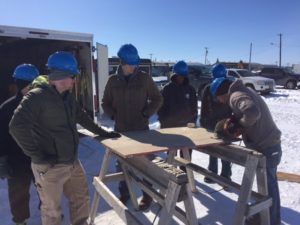
Six transitioning soldiers at Fort Drum, New York, learn the tools of the trade last spring during a six-week Construction Craft Laborer Course. This was the latest employment skills training program offered at the Fort Drum Soldier For Life-Transition Assistance Program. Army photo by Chris Gray
WASHINGTON — The Transition Assistance Program (TAP)—the joint effort by DoD, VA and DHS to help servicemembers transition to civilian life—is falling short of its goal, according to legislators and veterans’ advocates.
Regularly described by those who have gone through it as overwhelming and overstuffed, the TAP program can frequently leave servicemembers with a wealth of information but no clear direction on how to proceed. The responsibility for providing further guidance falls on a diffuse network of community services that, without significant organization, can lead to gaps in care.
In a House VA Subcommittee on Economic Opportunity hearing last month, Rep. Mike Levin (D-CA) called the TAP process “a tidal wave of information crashing down on our servicemembers as they prepare for civilian life.”
“The fact that TAP has shifted to an entirely online format further complicates things,” he added. “It limits interactions and impacts the quality of learning in a program that many argue is already too rote.”
The result can be new veterans who are unsure about where to turn to for help immediately post-discharge. A 2015 study of veterans, servicemembers and their dependents found that respondents cited navigating VA programs as their number one challenge, followed quickly by finding a job, adjusting to civilian culture, addressing financial challenges and applying military skills to civilian life.
Legislators looked at efforts in San Diego as one possible example of how to provide some coordination to the post-TAP process. While San Diego has only 1% of the national population, it houses 8% of active duty military personnel.
“Every year, 250,000 military servicemembers embark on the transition from active duty to civilian life. It’s not just a vocational change but a multifaceted monumental life change,” explained Maurice Wilson, vice president of the San Diego Veterans Coalition (SDVC). “While it’s important to provide career transition support and guidance, it’s equally and perhaps even more important that they receive support to transition their identity through cognitive and psychological support.”
A San Diego nonprofit, the coalition brings together 150 separate organizations that provide services to veterans in the city. The organization’s goal is to provide collaboration and coordination to help make sure that whatever assistance a veteran needs there’s somewhere they can go.
“We’re not looking to supplant TAP,” Wilson cautioned. “We’re looking to compliment what goes on in TAP.”
SDVC’s collective impact model helps dozens of smaller veteran-focused organizations come together under a common agenda and a shared understanding of the challenges. This helps close the gaps in services that veterans might otherwise slip through and help “reboot the lives and careers of transitioning servicemembers in San Diego,” Wilson said.
One Size Doesn’t Fit All
One thing that VA and DoD need to recognize with the TAP process is that there’s no one-size-fits-all approach for transitioning servicemembers and their families, explained Daniel Romero, director of the San Diego Military Family Collaborative, which acts as a hub for military families seeking resources. However, there are key metrics that can be used in determining whether a servicemember and their family transitions successfully.
Near the top is employment and finances, Romero said. “One of the things we’re noting in the community is underemployment of our veterans and their families. We need to find job that have some sustainability for the family to live at a comfortable level.”
VA has found that steady, fulfilling employment can be a significant protective factor against depression in new veterans.
Another key metric is social and emotional wellness. “Veterans lose a lot of support they’ve developed over the years as they transition from active duty to civilian,” Romero explained.
One challenge, even in San Diego with its entrenched military culture, is how few veterans take advantage of any of these services, federal or otherwise.
“Over 70% of the veterans out there are not engaged in anybody’s system,” Wilson declared. “Despite all the work, if we don’t have a process to capture them we’ll be forever spinning our wheels.”
At the national level, much is still not known about how successful the TAP program is in preparing servicemembers. Levin said he hopes to begin addressing that with a bill he introduced last year, The Navy SEAL Chief Petty Officer William “Bill” Mulder (Ret.) Transition Improvement Act.
Named after a veteran who committed suicide months after retiring from a 20-year career in the Navy, the bill would, among other things, require VA to hire an outside agency with experience in adult education to report on the efficacy of TAP. The bill would also mandate VA conduct a five-year longitudinal study of TAP on three separate cohorts of transitioned servicemembers.
The bill passed the House in May 2019 but has yet to be considered in the Senate.


